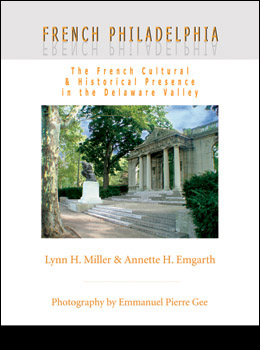
Front Cover Back Cover
French Philadelphia: The French Cultural & Historical Presence in the Delaware Valley ___________________________ This travel / guidebook is easy, pleasant reading which includes historical background, a selected bibliography and a listing of French-American organizations in the region. The following are six of the featured 59 color photographs, neighborhood maps and illustrations. |
|
 |
1. Joan of Arc, Emmanuel Fremiet's gilded equestrian statue, stands where the Parkway fades into Kelly Drive at the foot of the Art Museum, It is one of three castings--the others are in the Place des Pyramides in Paris and in Nancy, France. Fremiet (1894-1910) was a nephew of the celebrated sculptor, François Rude, with whom he worked after study at the Musée d'Histoire Naturelle in Paris. (pp. 68-69) |
 |
2. George Washington, central entrance of Independence Hall, by noted French sculptor Alexis Bailly. This is a copy of the original marble sculpture placed here in 1869 and later removed to City Hall for its protection. (p. 11) |
 |
3. General Lafayette, portrait by François Casanova, courtesy of the Athenaeum of Philadelphia. |
 |
4. The cafe Rouge, one of the many French-flavored cafes and restaurants in Philadelphia, probably the best-known would be Le Bec Fin and Brasserie Perrier. The French presence lives on in Philadelphia. Since 1999, the area around Rittenhouse Row has been officially recognized as the French Quarter, with orange markers beneath green street signs at several intersections north of Rittenhouse Square. Other French establishments nearby include Sofitel Philadelphia and restaurants La Castagne, Le Jardin, La Colombe Torrefaction and Le Bus Bakery. (adapted from p. 75) |
 |
5. The Philadelphia Museum of Art is rich in nearly every period of French Art. In 1929, the PMA acquired an important collection from the French connoisseur, Edmond Foulc [. . .]. In 1986, the McIlhenney collection added an unmatched trove of nineteenth-century French paintings to already impressive holdings. (pp. 70-71) |
 |
6. City Hall, the former site of William Penn's Center Square. When Rochambeau's troops marched "up" Chestnut Street in 1781, they were on their way to camps in Center Square. [. . .] The building was designed in the French Renaissance style, loosely modeled on the Louvre museum in Paris. |
 |
7. Carpenter's Hall: On September 4, 1774, the First Continental Congress assembled here. [. . .] Then in late December 1775, Benjamin Franklin and John Jay of the Committee of Secret Correspondence met [. . .] with an emissary of Louis XVI, Achard de Bonvouloir, [. . .] These secret discussions, with Francis Daymon acting as interpreter, focused on France's aid to the rebellious colonies and on the conditions of the commercial agreements this aid would require. (pp. 19-20) |
| French Philadelphia: The French Cultural & Historical Presence in the Delaware Valley | $19.95 |
Beach Lloyd Direct | |
| Amazon | |